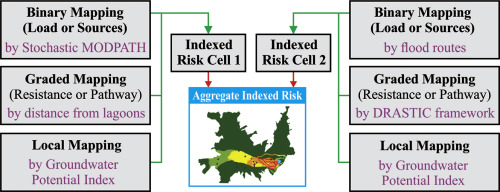当前位置:
X-MOL 学术
›
Environ. Impact Assess. Rev.
›
论文详情
Our official English website, www.x-mol.net, welcomes your
feedback! (Note: you will need to create a separate account there.)
Introducing a risk aggregation rationale for mapping risks to aquifers from point- and diffuse-sources–proof-of-concept using contamination data from industrial lagoons
Environmental Impact Assessment Review ( IF 9.8 ) Pub Date : 2018-09-01 , DOI: 10.1016/j.eiar.2018.05.008 Sina Sadeghfam , Yousef Hassanzadeh , Rahman Khatibi , Marjan Moazamnia , Ata Allah Nadiri
Environmental Impact Assessment Review ( IF 9.8 ) Pub Date : 2018-09-01 , DOI: 10.1016/j.eiar.2018.05.008 Sina Sadeghfam , Yousef Hassanzadeh , Rahman Khatibi , Marjan Moazamnia , Ata Allah Nadiri

|
Abstract Proof-of-concept for a methodology is presented on mapping risks to aquifers impacted from point- and diffuse-sources, where mapping or indexing refers to relative but not absolute values. The methodology is generic but tested by investigating impacts of a risk exposure from industrial wastewater lagoons. The methodology is innovative for using the qualitative Source-Pathways-Receptors-Consequences (SPRC) framework to aggregate risks from both point-sources and diffuse-sources through breaking down a study area into SPRC risk cells. In this paper, two risk cells are required as: (i) Cell 1 is directly impacted from a point-source; and (ii) Cell 2 is impacted by diffuse-sources to slowly contaminate the aquifer by infiltration over a large area. Indexing both types of risk cells generically comprise three tiered processes: (i) binary indexing establishes if a grid cell is at a potential risk or not; (ii) graded indexing measures the strength of the risk pathways from source to receptors; and (iii) local indexing measures intrinsic potentials at the grid cell to propagate the risk. These three processes apply to both point- and diffuse-sources but with different mathematical formulations. The proof-of-concept for the methodology of risk aggregation using the SPRC framework is supported by results of a study area, in which a set of performance metrics are used by comparing with the measurements. The results are found to be fit-for-purpose for serving as proactive management tools and to provide a deeper insight into potential impacts of adverse effects.
中文翻译:

引入风险汇总原理,以使用来自工业泻湖的污染数据将风险从点源和扩散源映射到含水层的概念验证
摘要 提出了一种方法的概念验证,用于绘制受点源和扩散源影响的含水层的风险,其中映射或索引指的是相对值而不是绝对值。该方法是通用的,但通过调查工业废水泻湖风险暴露的影响进行了测试。该方法是创新的,使用定性源-路径-受体-后果 (SPRC) 框架通过将研究区域分解为 SPRC 风险单元来汇总来自点源和扩散源的风险。在本文中,需要两个风险单元: (i) 单元 1 直接受到点源的影响;(ii) 单元 2 受到扩散源的影响,通过大面积渗透缓慢污染含水层。对两种类型的风险单元进行索引通常包括三个分层过程:(i) 二进制索引建立网格单元是否处于潜在风险中;(ii) 分级索引衡量从源到受体的风险路径的强度;(iii) 局部索引测量网格单元的内在潜力以传播风险。这三个过程适用于点光源和漫射光源,但具有不同的数学公式。使用 SPRC 框架的风险聚合方法的概念验证得到了研究领域结果的支持,其中使用一组性能指标与测量值进行比较。结果发现适合用作主动管理工具,并提供对不利影响的潜在影响的更深入的洞察。(ii) 分级索引衡量从源到受体的风险路径的强度;(iii) 局部索引测量网格单元的内在潜力以传播风险。这三个过程适用于点源和漫射源,但具有不同的数学公式。使用 SPRC 框架的风险聚合方法的概念验证得到了研究领域结果的支持,其中使用一组性能指标与测量值进行比较。结果发现适合用作主动管理工具,并提供对不利影响的潜在影响的更深入的洞察。(ii) 分级索引衡量从源到受体的风险路径的强度;(iii) 局部索引测量网格单元的内在潜力以传播风险。这三个过程适用于点源和漫射源,但具有不同的数学公式。使用 SPRC 框架的风险聚合方法的概念验证得到了研究领域结果的支持,其中使用一组性能指标与测量值进行比较。结果发现适合用作主动管理工具,并提供对不利影响的潜在影响的更深入的洞察。这三个过程适用于点源和漫射源,但具有不同的数学公式。使用 SPRC 框架的风险聚合方法的概念验证得到了研究领域结果的支持,其中使用一组性能指标与测量值进行比较。结果发现适合用作主动管理工具,并提供对不利影响的潜在影响的更深入的洞察。这三个过程适用于点源和漫射源,但具有不同的数学公式。使用 SPRC 框架的风险聚合方法的概念验证得到了研究领域结果的支持,其中使用一组性能指标与测量值进行比较。结果发现适合用作主动管理工具,并提供对不利影响的潜在影响的更深入洞察。
更新日期:2018-09-01
中文翻译:

引入风险汇总原理,以使用来自工业泻湖的污染数据将风险从点源和扩散源映射到含水层的概念验证
摘要 提出了一种方法的概念验证,用于绘制受点源和扩散源影响的含水层的风险,其中映射或索引指的是相对值而不是绝对值。该方法是通用的,但通过调查工业废水泻湖风险暴露的影响进行了测试。该方法是创新的,使用定性源-路径-受体-后果 (SPRC) 框架通过将研究区域分解为 SPRC 风险单元来汇总来自点源和扩散源的风险。在本文中,需要两个风险单元: (i) 单元 1 直接受到点源的影响;(ii) 单元 2 受到扩散源的影响,通过大面积渗透缓慢污染含水层。对两种类型的风险单元进行索引通常包括三个分层过程:(i) 二进制索引建立网格单元是否处于潜在风险中;(ii) 分级索引衡量从源到受体的风险路径的强度;(iii) 局部索引测量网格单元的内在潜力以传播风险。这三个过程适用于点光源和漫射光源,但具有不同的数学公式。使用 SPRC 框架的风险聚合方法的概念验证得到了研究领域结果的支持,其中使用一组性能指标与测量值进行比较。结果发现适合用作主动管理工具,并提供对不利影响的潜在影响的更深入的洞察。(ii) 分级索引衡量从源到受体的风险路径的强度;(iii) 局部索引测量网格单元的内在潜力以传播风险。这三个过程适用于点源和漫射源,但具有不同的数学公式。使用 SPRC 框架的风险聚合方法的概念验证得到了研究领域结果的支持,其中使用一组性能指标与测量值进行比较。结果发现适合用作主动管理工具,并提供对不利影响的潜在影响的更深入的洞察。(ii) 分级索引衡量从源到受体的风险路径的强度;(iii) 局部索引测量网格单元的内在潜力以传播风险。这三个过程适用于点源和漫射源,但具有不同的数学公式。使用 SPRC 框架的风险聚合方法的概念验证得到了研究领域结果的支持,其中使用一组性能指标与测量值进行比较。结果发现适合用作主动管理工具,并提供对不利影响的潜在影响的更深入的洞察。这三个过程适用于点源和漫射源,但具有不同的数学公式。使用 SPRC 框架的风险聚合方法的概念验证得到了研究领域结果的支持,其中使用一组性能指标与测量值进行比较。结果发现适合用作主动管理工具,并提供对不利影响的潜在影响的更深入的洞察。这三个过程适用于点源和漫射源,但具有不同的数学公式。使用 SPRC 框架的风险聚合方法的概念验证得到了研究领域结果的支持,其中使用一组性能指标与测量值进行比较。结果发现适合用作主动管理工具,并提供对不利影响的潜在影响的更深入洞察。











































 京公网安备 11010802027423号
京公网安备 11010802027423号